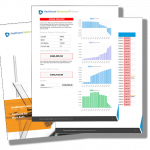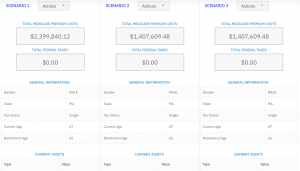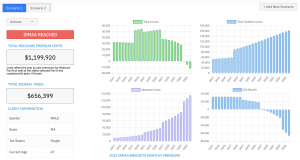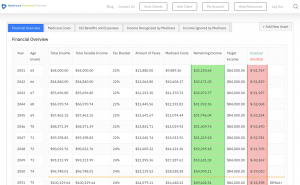Imagine staring at a screen that displays your Modified Adjusted Gross Income (MAGI), with the figure higher than you’d like. Thinking to myself, “What can I do to lower my MAGI?” How can I possibly get my MAGI down?”
The world of personal finance often feels like a maze. But there’s no need to feel overwhelmed or stuck in it. Today, we’ll be your compass guiding you through the winding paths.
We’re diving into strategies on how to reduce Modified Adjusted Gross Income (MAGI), from making pre-tax contributions to retirement plans and health savings accounts, to optimizing tax benefits and deductions.
This isn’t just about figures—it’s about giving you power over your monetary destiny. Ready for some insider tips that could save you big bucks come tax season?
Understanding MAGI and Its Importance
Your taxable income isn’t just your salary or wages. Gross income encompasses not only wages and salary, but also gratuities, profits from investments, and other forms of earned money. This is what’s known as gross income.
The Internal Revenue Service (IRS) gives you a chance to reduce this figure through certain deductions like student loan interest or alimony payments. The result? Your adjusted gross income (AGI).
But there’s another crucial number that impacts your tax liability: the modified adjusted gross income (MAGI). Here’s why it matters.
MAGI Calculation – More Than Just Ordinary Income
To calculate MAGI, we start with AGI then add back some specific deductions. Why does the IRS care about this calculation?
MAGI determines eligibility for many tax benefits such as Roth IRA contributions where higher earners are phased out of contributing directly to their Roth IRAs due to these limits based on their MAGIs.
In 2017 for example, if you were single and wanted to contribute the full $5,500 to a Roth IRA, your MAGI needed to be less than $118k; for married couples filing jointly it had be below $186k.
This shows how essential understanding our own financial picture becomes when planning personal finance strategies.
Taxable Income Versus Tax Liability
“Not everything that can be counted counts.”
-Albert Einstein-
And so goes with your taxable income. Not only the amount of your earnings, but also their nature and how they are regarded by the IRS will affect your taxable income.
Your MAGI can impact various tax credits too like premium subsidies for health insurance under the Affordable Care Act (ACA). The lower your income, generally speaking, the larger subsidy you’ll get.
It’s important to know where you stand with your gross income, adjusted gross, and modified adjusted. This knowledge helps in managing your finances effectively.
Key Takeaway:
Grasping your MAGI, or modified adjusted gross income, is crucial as it affects tax benefits like Roth IRA contributions and health insurance subsidies. It’s more than just your salary; it includes bonuses, capital gains, tips and allows for certain deductions. By understanding this number alongside your gross income and AGI (adjusted gross), you can manage finances effectively.
Table of Contents:
- Understanding MAGI and Its Importance
- Strategies to Reduce MAGI for High Earners
- Optimizing Tax Benefits and Deductions to Reduce MAGI
- Planning for MAGI Reduction in Different Life Situations
- Utilizing Health Savings Accounts (HSA) to Reduce MAGI
- Calculating MAGI and Reporting to the IRS
- FAQs in Relation to How to Reduce Magi
- Conclusion
Strategies to Reduce MAGI for High Earners
If you’re a high earner, lowering your Modified Adjusted Gross Income (MAGI) might seem like a tall order. But with strategic planning and smart financial decisions, it’s entirely possible.
Making Pre-tax Contributions to Retirement Plans
One way is by maximizing contributions to retirement plans like traditional IRAs or 401(k)s. Since these are made pre-tax, they can significantly reduce your taxable income. For instance, in 2017 the contribution limit was $5,500 for a Roth IRA but remember that if you’re earning over $118k as an individual or $186k jointly your ability to contribute starts phasing out.
Utilizing Health Savings Accounts
An HSA offers dual benefits – it not only helps cover medical expenses but also reduces taxable income when used correctly. However there’s a catch; the IRS sets limits on who can make contributions: singles with MAGI above $133K and joint filers exceeding $196K are left out (Instructions for Schedule C).
Innovative strategies like these allow high earners to navigate around phase-outs while simultaneously preparing financially secure futures.
A Little More About HSAs and possible deduction…
The magic of HSAs lies in their triple tax benefit – contributions aren’t taxed when made, earnings grow tax-free and withdrawals for qualified medical expenses come out untaxed. That means every dollar contributed lowers your MAGI accordingly.
Don’t Forget About FSAs
If an HSA isn’t a fit for your situation, don’t forget about Flexible Spending Accounts (FSAs). These are another tax-advantaged way to pay for eligible health care expenses but with one big difference – FSA contributions do not roll over year-to-year like HSAs.
Optimizing Tax Benefits and Deductions to Reduce MAGI
If you’re searching for methods to reduce your Modified Adjusted Gross Income (MAGI), tax advantages and deductions are a great way to begin. By leveraging these opportunities, you can potentially qualify for more financial aid or avoid higher Medicare premiums.
Understanding the Impact of Capital Gains and Losses
Selling taxable investments at a loss can help reduce your MAGI. This is because capital losses offset capital gains, which in turn reduces your total income subject to taxes. The key here is balancing between realizing profits from selling high-performing assets versus claiming losses on underperforming ones.
This approach not only helps manage investment risks but also plays an important role in reducing your overall taxable income Schedule 1 for Form 1040. Remember though that this strategy needs careful planning as overdoing it could hurt long-term investment goals.
Leveraging Student Loan Interest Deduction
The interest paid on student loans can be deducted from your gross income up until a certain limit, further lowering MAGI. Taxpayers earning up to $85k (or $170k if filing jointly) annually may reduce their AGI by deducting a maximum of $2500 in student loan interest payments.
Taking Advantage of Adoption Tax Credit
If you’ve recently expanded your family through adoption, don’t forget about the adoption tax credit – it’s another way how families may reduce their AGI significantly. It covers eligible expenses like court costs or legal fees related directly with adopting a child (Form 8839 Qualified Adoption Expenses).
Health Insurance Premium Deductions
If you’re self-employed, don’t overlook the health insurance premium deductions. Premiums paid for yourself, your partner, dependents and children below 27 can be deducted on line 29 of Form 1040 or Schedule C if you’re self-employed.
When you deduct these amounts on line 29 of Form 1040, or Schedule C if you’re running a sole proprietorship, it directly reduces your taxable income. This reduction can be a powerful tool in managing your tax obligations effectively.
Key Takeaway:
Reducing your MAGI can unlock more financial aid and dodge high Medicare premiums. Capital losses on investments, student loan interest deductions, adoption tax credits, and health insurance premium deductions for the self-employed are smart strategies to lower taxable income. However, balance is crucial – don’t compromise long-term goals for short-term benefits.
Planning for MAGI Reduction in Different Life Situations
Your life situation can greatly influence your ability to reduce Modified Adjusted Gross Income (MAGI). Let’s discuss three specific scenarios: self-employment, high earners with multiple income sources, and families with children.
Self-Employment Strategies
If you’re your own boss, paying for medical coverage can be a big expenditure. But here’s the silver lining: these costs are deductible on your taxes. This deduction not only lowers your tax bill but also reduces your MAGI which could potentially lead to bigger premium subsidies under the Affordable Care Act (ACA).
The 2023 Federal Poverty Level Numbers, show that lower income results in a larger ACA subsidy. As a result, this is one way of optimizing personal finance while being mindful of potential health care expenses.
Tactics for High Earners with Multiple Income Sources
High earners often face higher Medicare IRMAA charges due to their elevated MAGI levels. One approach might be making maximum contributions into retirement accounts like traditional IRA or Roth IRA as well as Health Savings Accounts (HSA) if eligible. These actions will not only help build up funds for retirement but also reduce AGI by lowering taxable income.
You need to know that contribution limits apply – it phases out gradually as incomes rise; no contributions allowed if MAGI exceeds $133k for singles or $196k for married couples filing jointly according to IRS Publication 590-A rules. IRS guidelines
Families with Children
If you have kids, adoption benefits can play a significant role in reducing MAGI. The Adoption Tax Credit is designed to help defray the expenses associated with adoption, thus reducing your Adjusted Gross Income (AGI) and Modified Adjusted Gross Income (MAGI).
Remember, this isn’t just about cutting down your income tax. It’s also a powerful strategy to lower both AGI and ultimately MAGI.
Key Takeaway:
Life Situations Matter: Your life situation shapes your strategy to lower MAGI. If you’re self-employed, deduct health insurance premiums. High earners should max out retirement and Health Savings Accounts contributions. Families can use adoption benefits for tax credits.
Utilizing Health Savings Accounts (HSA) to Reduce MAGI
An underappreciated gem in the world of personal finance, Health Savings Accounts (HSAs), can be a potent tool for reducing your Modified Adjusted Gross Income (MAGI). Not only do they offer health care flexibility, but their contribution limits and tax advantages also make them an effective income reducer.
The trick lies in understanding how HSA contributions work. HSAs are linked with high-deductible health insurance plans. This means you’ll need such a plan to open one. But once it’s up and running, you get to enjoy some serious benefits.
Making Contributions
First off, any sum that is put into your HSA can be pre-tax or tax-deductible if it was contributed post-tax. For 2023, individuals with self-only coverage could contribute up to $3,600 pre-tax/post-tax; for family coverage it’s as much as $7,200 plus an extra grand if you’re 55 or older. These numbers rise by another grand if you’re 55 years old or more due to catch-up contributions. Berkeley Labor Center provides an excellent summary of these rules.
This might not sound like a lot at first glance – after all most people earn way more than what they can contribute here annually. But every little bit helps when trying to reduce MAGI because it directly lowers the income on which ACA premium subsidies are calculated.
Hitting Two Birds With One Stone
You see the real magic happens when we realize that not only does contributing help us save taxes now but spending from these accounts on qualified medical expenses comes out tax-free too. Yes. You read that right – neither your original contribution nor the interest it earned gets taxed when spent right. Now that’s what I call hitting two birds with one stone.
Now you might ask – What happens if my medical expenses don’t match up to these contributions? Good question. Any unused money in your HSA rolls over indefinitely, allowing you to build a substantial nest egg for future health care costs.
Key Takeaway:
Health Savings Accounts (HSAs): An underrated tool in personal finance, HSAs can help lower your Modified Adjusted Gross Income. Coupled with high-deductible health plans, they offer pre-tax contributions and tax-free medical expense withdrawals. Plus, unused funds roll over indefinitely for future healthcare costs.
Calculating MAGI and Reporting to the IRS
To accurately report your Modified Adjusted Gross Income (MAGI) to the Internal Revenue Service (IRS), it is essential to have an understanding of how this figure is determined. Here, we’ll break down what goes into this crucial figure.
MAGI Calculation Basics
Your MAGI starts with your adjusted gross income (AGI). This includes all taxable income such as wages, interest, capital gains, and retirement distributions minus certain deductions like student loan interest or contributions to traditional IRAs. To get from AGI to MAGI for IRS purposes, add back specific items like tax-exempt interest or non-taxable Social Security benefits.
The good news is that Form 1040, used by many taxpayers, can help guide you through these calculations in its various lines and schedules.
Tax Return Essentials
Once you’ve determined your MAGI using Form 1040 and other relevant documents like W-2s or 1099 forms for self-employed individuals, it’s time to file your return with the IRS. Your total income will be listed on line 7b of Form 1040; however, remember that this amount may not match up exactly with your final reported MAGI due to added-back adjustments.
You should know that reporting incorrect figures could potentially lead towards penalties from the IRS – so precision counts.
Navigating Phase Outs And Contribution Limits With The Help Of Your Tax Advisor
Knowing how much money falls within particular phase-out ranges based on one’s filing status is key when considering IRA contributions because contribution limits decrease as incomes increase beyond those thresholds.
For example: In terms of Roth IRAs – if you’re single and your MAGI exceeds $133k, or if married filing jointly and it’s over $196k – you can’t contribute at all.
While the calculation might seem complicated, professional tax advisors are there to help navigate these complex rules. They can ensure that you’re making the most of every opportunity for reducing taxable income and maximizing retirement savings.
Key Takeaway:
Starting with your AGI, you add back certain items such as tax-exempt interest to calculate your MAGI. To get this number right, use Form 1040 and any other relevant documents before sending anything off to the IRS. It’s crucial because if you mess up the figures, there could be penalties. The whole process of figuring out phase-outs and contribution limits can feel like a maze sometimes. But don’t sweat it – a tax advisor can give you a hand in making sure you reduce your income in the best way possible.
FAQs in Relation to How to Reduce Magi
How to reduce modified adjusted gross income (MAGI)?
You can lower your MAGI by making pre-tax contributions to retirement plans, using health savings accounts, and taking advantage of various deductions.
What reduces gross income to adjusted gross income?
Certain expenses like student loan interest, self-employed health insurance premiums, and IRA contributions help trim down your gross income to the adjusted one.
Does 401k reduce MAGI?
Absolutely. Your pre-tax contributions towards a 401(k) are excluded from taxable earnings, hence lowering your MAGI.
Does HSA reduce my MAGI?
Sure does. Contributions made into Health Savings Accounts are tax-deductible which results in a reduction of your overall MAGI.
Conclusion
So, you’ve navigated the labyrinth of personal finance. You now know how to reduce your MAGI and take control of your financial future.
Pre-tax contributions to retirement plans? Check. Using health savings accounts strategically? Absolutely. Optimizing tax benefits and deductions for a lower MAGI? No question about it.
You’re ready to report accurately to the IRS, with an understanding of different life situations impacting your earnings and tax obligations.
This is just the start—keep these strategies at hand as they can help shape your approach towards managing income effectively.
In short: More knowledge means less stress come tax season—and that’s a win in anyone’s book!
Streamlining the Medicare Surcharge Calculation Process.
Our Healthcare Retirement Planner software is designed to streamline the retirement planning process for financial professionals. By providing an efficient way to calculate IRMAA costs, our tool helps you save time and focus on other aspects of your clients’ retirement plans.
- Faster calculations: Our software quickly calculates IRMAA costs based on your client’s income and tax filing status, eliminating manual calculations and potential errors.
- User-friendly interface: The intuitive design of our platform makes it easy for financial professionals to input data and generate results with minimal effort.
- Data integration: Seamlessly integrate our calculator into your existing financial planning tools or CRM systems for a more streamlined workflow.
- Easy to Understand Reports: Export reports to easily share with your clients
- Tax and Surcharge Modeling: see how different types of income affects both taxes and your surcharges.
In addition to simplifying the calculation process, using our Healthcare Retirement Planner can also help improve communication between you and your clients. With clear visuals that illustrate how IRMAA costs impact their overall retirement plan, you can effectively convey complex information in an easily digestible format. This enables clients to make informed decisions about their healthcare expenses during retirement while ensuring they are prepared for any potential changes in Medicare premiums due to income fluctuations. To learn more about how our software can benefit both you as a financial professional and your clients’ retirement planning experience, visit the features page. Streamlining retirement planning processes can help financial professionals save time and resources, allowing them to focus on other areas of their clients’ needs. Automated calculation of IRMAA costs is the next step in streamlining this process even further.





